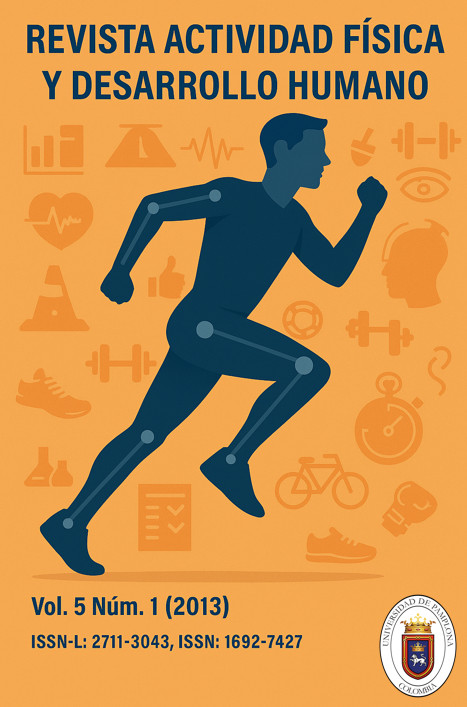Modelo escalonado con formación en el tetratlón para el atletismo en la categoría infantil femenino
DOI:
https://doi.org/10.24054/afdh.v5i1.1693Palabras clave:
Tetratlon, formación atlética infantil femeninaResumen
La presente investigación tuvo la finalidad de Estructurar un modelo escalonado para mejorar la formación deportiva del tetratlon en el atletismo en la categoría infantil femenino del club guepardos de la ciudad de pamplona. El estudio se ubicó en una investigación de campo, de tipo cuali- cuantitativo con método de investigación cuali -cuantitativo
.Se utilizó una población de 18 niñas de 11 y 12 años del club guepardos de atletismo de pamplona y la muestra fue de 18 obtenida por destacarse en este deporte.
Para la validación del modelo escalonado con formación en el tetratlon en el atletismo en la categoría infantil se realizó una encuesta de 10 preguntas dirigidas a los entrenadores colombianos de esta categoría, en la ciudad de Bucaramanga en el torneo nacional de freska leche donde se reúnen cada año a mostrar su trabajo realizado con los niños y niñas de la categoría infantil, donde la encuesta averigua que modelo es el más utilizado por ellos hacia la formación de estas niñas que están a su cargo. La prueba del tetratlon es el parámetro de medición de progreso a los dos grupos con el modelo más utilizado de formación básica en el atletismo y el modelo escalonado con formación en el tetratlon a fin de determinar la confiabilidad por medio de análisis de la prueba t student, análisis de muestras relacionadas y la prueba z. El cual nos determinó que en las muestras que se aplicaron los dos modelos se evidenciaron diferencias significativas pero el modelo escalonado supero en tiempos y distancias al modelo de formación básica en las 4 pruebas del tetratlon. Los datos se procesaron con el programa SPSS y su análisis se fundamentó en la relación de muestras relacionadas .Se concluyó que el modelo escalonado tiene una estructura de enseñanza y aprendizaje por medio de juegos más confiable y eficaz para obtener mejoras en las pruebas del tetratlon por la polivalencia desarrollada en las niñas el saber ejecutar las diferentes habilidades básicas que tiene esta prueba atlética infantil y que lo importante es desarrollar en ellas esas fortalezas a nivel general y no especificarlos .Se recomendó continuar con este proceso para lograr aumentar el número de participantes por delegaciones en la prueba del tetratlon en los campeonatos municipales departamentales y nacionales para que las niñas que traen un proceso de formación en el tetratlon de una misma delegación puedan participar todas ellas, ya que es una prueba que no se le ha dado la importancia y es la base de nuestra formación infantil
Descargas
Referencias
ACOSTA, L. (2000). Tempos de crecimiento de las carreras de velocidad y vallas. Ciudad Habana, Manuscrito. Trabajo de Diploma. Instituto Superior de Cultura Física Manuel Fajardo.
ALONSO D. Y CAMPO,J.M : Habilidades atléticas en la formación inicial vol. pp.249- 258. Universidad de castilla
ALAMOND, L. Y DEVIS, J. (1989) Hacia la construcción de una perspectiva diferente del atletismo en las escuelas", Revista Educación Física. Número 29 y 30. Septiembre a Diciembre de 1.989., p. 38-41
ÁLVAREZ DEL VILLAR, C. (1994) Atletismo Básico. Una orientación pedagógica. Editorial Miñón. Madrid.
ANAYA, FUENTES Y GONZALEZ F.(2005) Atletismo formativo.
BALSEWITSCH (U.R.S.S.) (1.977). ¿Cuándo debe empezar la formación de corredores?. Cuadernos de Atletismo, número 7. R.F.E.A.
BERMUDEZ Y CHAURRA J. (2001) Orientaciones para la planificación del entrenamiento en niños .Editorial.
BETANCOURT MELLA, LÁZARO. (1991). Atletismo en el ámbito escolar y deportivo. La Habana, Editorial Pueblo y Educación. 185p.
BOMPA, T. (1987). La selección de atletas con talento. Entrenamiento Deportivo. Vol. No2, 46- 54.
CAMPO J.M Y ALONSO D.(2000). Un modelo para la enseñanza del atletismo en primaria. En Ruiz , Ortiz , M.M La educación física ante los retos del nuevo milenio pp.273-278 Centro de profesorado de nueva granada.
CAMPOS, J.; GALLACH (2004). Las técnicas de atletismo. Manual práctico de Enseñanza. Editorial Paidotribo. Barcelona
CASTAÑEDA, J. Y COL. (2001). Programa de Iniciación en la etapa de formación básica del Atletismo cubano edades 8-11 años. Ciudad de la Habana, soporte magnético.
CURIEL, DEL CAMPO (2001) Iniciación del atletismo en primaria. Editorial
DARIAS Y CORDERO (2004). Juegos para la formación del atletismo en atletas de 10 y 11 años femenino en carreras de velocidad. Editorial.
DIETRICH M, JURGEN N, CHISTINE O,
KLAUS R, 2004 “Metodología general del entrenamiento infantil y juvenil “. Editorial Paidotribo
DIONISIO, A. Y JUAN DEL, C. (2001) Iniciación al atletismo en primaria. Publicaciones INDE, Barcelona España.
FROMETA, MORALESY ELEJALDE (2006).Programa de formación básica del atleta cubano de disciplinas múltiples. Editorial GIL, F.; PASCUA, M.; SÁNCHEZ, R.; (2000) Manual Básico del Atletismo. Editorial paidotribo
LOPEZY ZEQUERA F. (1998) Modelo de Programa de formación básica del atletismo infantil para niños de 10 a 11 años .Editorial
OZOLIN Y D. P. HARKOV. (1991). Atletismo. La Habana, Editorial Científico Técnica
POLISCHUK V.(1995) Iniciación y perfeccionamiento .Editorial paidotribo
RUBIO J.(2005) Nuevas tendencias del atletismo para niños .Editorial paidotribo
SANT J.(2005) Metodología y técnicas de atletismo. Editorial
Descargas
Publicado
Número
Sección
Licencia
Derechos de autor 2013 ACTIVIDAD FÍSICA Y DESARROLLO HUMANO

Esta obra está bajo una licencia internacional Creative Commons Atribución-NoComercial-SinDerivadas 4.0.











